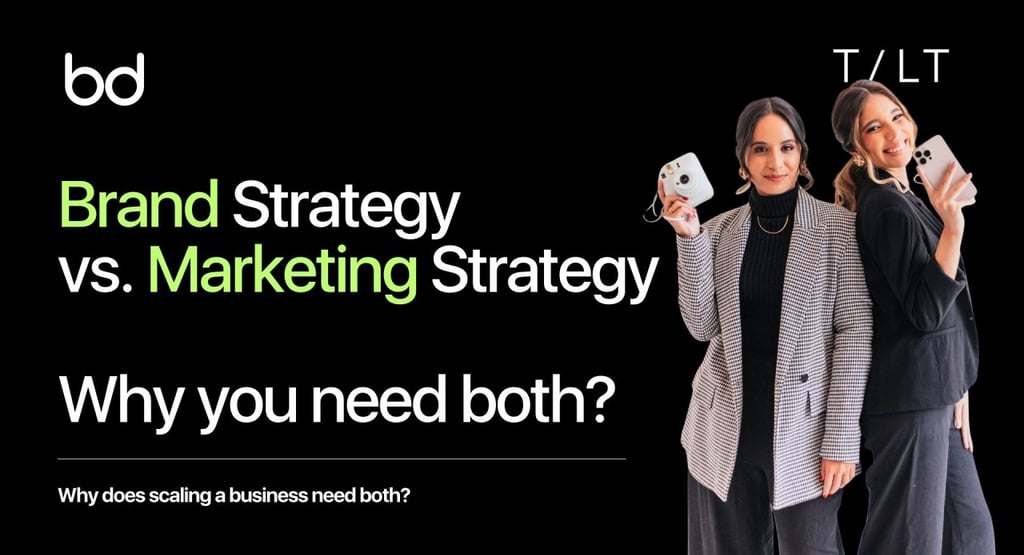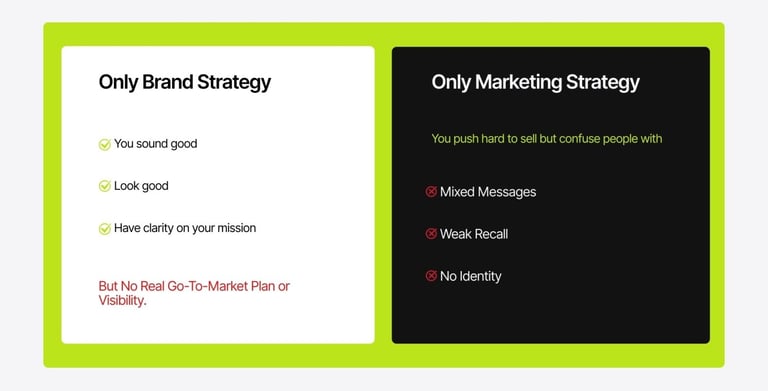Brand Strategy vs. Marketing Strategy: Here's Why You Need Both to Scale
Brand strategy and marketing strategy are distinct. They’re not interchangeable. And relying on one without the other is like building a house on sand. If your business is at a growth inflection point or hitting a growth ceiling, this article will show you why brand strategy and marketing strategy must work together to achieve long-term, scalable success.
Brand Blinks Global
4 min read


In today’s crowded, hyper-connected market, businesses often chase marketing tactics in hopes of scaling, new ads, campaigns, influencers, and SEO hacks. But without a clear brand strategy, even the best marketing can fall flat.
Brand strategy and marketing strategy are distinct. They’re not interchangeable. And relying on one without the other is like building a house on sand.
If your business is at a growth inflection point or hitting a growth ceiling, this article will show you why brand strategy and marketing strategy must work together to achieve long-term, scalable success.
What Is Brand Strategy?
Brand strategy is the long-term blueprint that defines who you are, what you stand for, how you're perceived, and where you're headed.
It's rooted in positioning, purpose, values, identity, and audience insight.
Think of it as your internal compass, it shapes your:
+ Brand Purpose – Why your brand exists beyond profit
+ Positioning – How you're different and why it matters
+ Voice & Tone – How you speak and sound across all touchpoints
+ Core Messaging – What you consistently communicate
+ Visual Identity – The logo, colours, typography, and overall look & feel
+ Customer Perception – How you want your audience to feel about you
It’s not flashy or reactive. It’s strategic, consistent, and deeply foundational.
What Is Marketing Strategy?
Marketing strategy is how you take your brand to market. It’s tactical, adaptive, and execution-driven.
It includes:
+ Campaign Planning
+ Media Channels (e.g., Meta, Google, YouTube)
+ Promotions, Offers & Funnels
+ Audience Targeting
+ Content Strategy
+ KPIs & Conversion Goals
Marketing answers the question: "How do we get more of the right people to engage, buy, and return?"
Where brand strategy is about who you are, marketing strategy is about how you reach and influence your audience.
Why You Need Both to Scale
Here’s what happens when you lean too heavily on one and ignore the other:
To scale, you need both.
Red Flags: When You’re Relying Too Much on Marketing Alone
You’re constantly changing offers to get people to click.
You can’t explain what makes you different in one sentence.
Your campaigns feel disjointed across platforms.
You’re spending a lot, but brand loyalty is weak.
Your logo and messaging keep evolving with trends.
Sound familiar? That’s a brand strategy problem.
The Interdependency: How They Feed Each Other
+ Your Brand Strategy Informs Your Marketing Strategy
Without brand positioning, your marketing lacks depth. You might end up targeting the wrong audience, using the wrong tone, or relying on discounts instead of trust.
Example: A wellness startup with premium pricing needs to establish trust, emotional clarity, and transformation-based messaging. Without that, marketing teams may default to price-based ads that dilute the brand.
+ Your Marketing Strategy Amplifies Your Brand Strategy
Once your brand is clearly defined, marketing becomes much more efficient. Your campaigns feel cohesive, your message stays consistent across touchpoints, and you don’t reinvent the wheel every quarter.
Example: Apple Every ad, product release, and experience echoes the same brand principles: simplicity, creativity, and premium design. Their marketing is powerful because the brand is so well-defined.
Brand-First vs. Marketing-First
Brand-Less Marketing
A new D2C brand spends 6L/month on performance ads with fancy visuals. Clicks come in, but people don’t remember the brand. No organic traction. No community.
→ Result: High CAC. Low retention. Margins eroded.
Brand-Driven Marketing
A wellness SaaS product aligns its messaging, customer journey, and visual identity before launching ads.
They know exactly who they serve, why it matters, and how to communicate it consistently.
→ Result: Lower CAC, higher conversion, better LTV, more word-of-mouth.
Scaling with Both Strategies
Let’s say you’re a fashion label hitting ₹2 Cr in annual revenue. You want to 3x next year.
Without Brand Strategy:
You test reels, run influencer drops, and do collabs.
You get inconsistent outcomes.
Every campaign feels like starting from scratch.
With Brand + Marketing Strategy:
+ You define your customer archetypes and emotional hooks.
+ Your tone and style remain consistent across touchpoints.
+ You build campaigns on a strong narrative (not random offers).
+ You become recognisable, not just visible.
Here are Some Signs You Have Both in Place
+ Your team can articulate what your brand stands for, not just what it sells.
+ Your content feels cohesive across channels, even with different campaigns.
+ You’re not just chasing reach, you’re building reputation.
+ Customers describe you in ways that match your brand purpose.
+ Marketing becomes more efficient over time, not more expensive.
What Do You Do Next?
Audit your brand – Are your voice, visuals, and values aligned?
Clarify your brand promise and positioning – Can your team explain it in 10 seconds?
Map your marketing channels to brand touchpoints – Make sure each channel reflects your brand personality.
Stop running isolated marketing campaigns – Start building on top of a strong strategic foundation.
Or let us do the work for you.


© 2025 BRNDXMORPH Media Worldwide Private Limited. All rights reserved
Brand Blinks Global is an independent global brand intelligence x transformation company.
The trademarks, logos, and service marks displayed on this site are the property of their respective owners.
"Brand Blinks Global," "Brand Blinks," "Made for the Uncommon," and the "bd" logo are trademarks or registered trademarks of BRNDXMORPH Media Worldwide Private Limited.
RESOURCES
INTELLIGENCE
BUSINESS
PARTNERSHIPS
COVERAGE
EXPLORE
Made for the Uncommon


When your brand grows, others rise too. 2% of your project empowers a nonprofit we back together every year.


